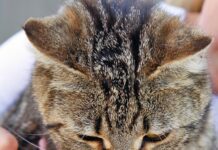Your cat’s whiskers are a sensitive part of her anatomy. Also called vibrissae, whiskers are touch-sensitive hairs that grow in a couple of locations around your cat’s body. The most notable site is on the muzzle.
Muzzle whiskers help cats navigate in dark areas. They also guide a cat as to whether she can fit through a narrow space. In addition, whiskers are part of a cat’s body language and used to help express emotions.
You may have heard about “whisker fatigue” in cats, which may arise from overstimulation of the whiskers, such as may occur while eating out of a narrow food bowl that causes the whiskers to constantly touch the sides of the bowl. A study from the Animal Medical Center in New York City looked at this potential problem.
Forty cats were volunteered by their owners to eat out of their regular bowls and then out of special “whisker friendly” bowls (38 cats completed the study). Half of them used ceramic bowls and half used stainless-steel bowls. At the beginning of the study, each cat had facial photos and whisker measurements taken. Their normal bowls were measured, and they were given test bowls of the same type of material.
Each cat was fasted for 12 hours then fed out of her regular bowl. A week later, this procedure was repeated, but the new bowl was used instead. A day after the test, the cats were offered food from both bowls to see if they preferred one.
Cats were videotaped eating with both types of bowl, so that a comparison of how much was eaten, if food was dropped, and how much time each cat spent eating could be made. No differences were found between the two types of bowls, but 63% of the owners felt their cats preferred the “whisker friendly” bowls. That information, of course, is a subjective evaluation.
Obviously, the study needs to be repeated with more cats and with the owners “blinded” as to which type of dish the cat was eating from. Also, different types of food should be evaluated, as this study only used dry food.n
Slovak JE, Foster TE. Evaluation of whisker stress in cats. J Feline Med Surg [Internet]. 2020 Jun 15 [cited 2020 Jun 15];1098612X2093019




